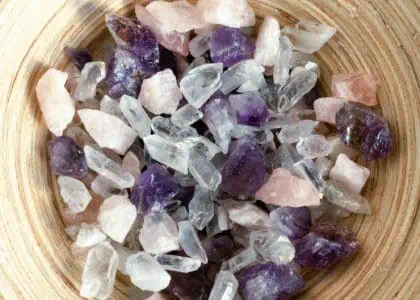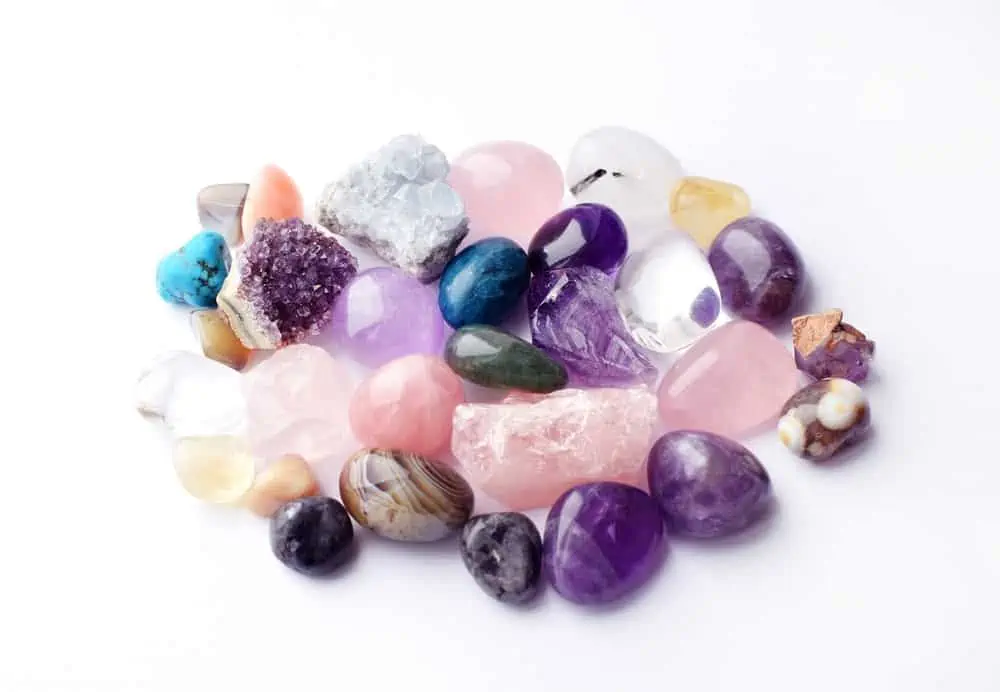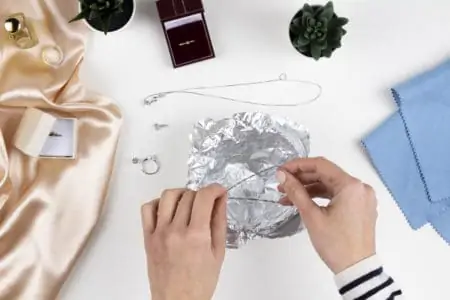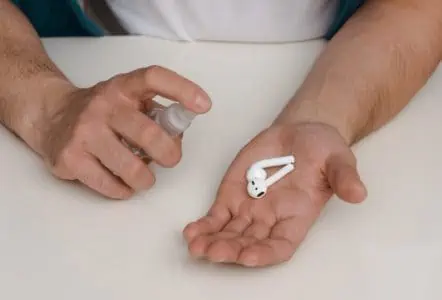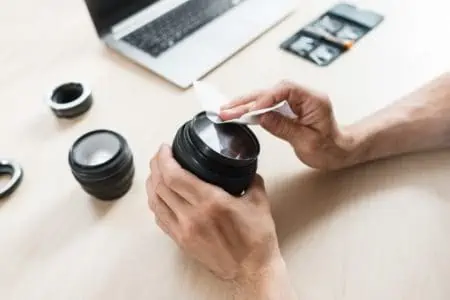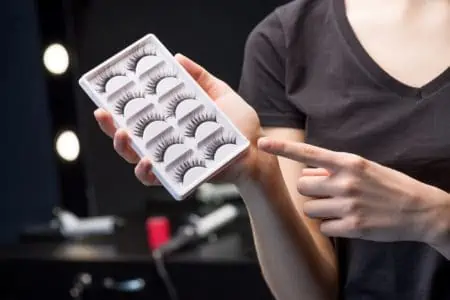If you’re collecting rocks, geodes, and crystals from the beach or from the river, you need to know how to clean rocks and crystals properly. Using the wrong type of chemical cleaner may dissolve your beautiful find. Or you may scratch your raw gemstones using abrasives.
The secret to cleaning rocks is to know the chemical makeup of your rock as well as the Mohs hardness.
Key Takeaways
- Clean rocks and crystals using soapy water and a nylon brush to scrub off dirt and gunk.
- Know the Mohs hardness and chemical makeup of your rock before cleaning to avoid damage or dissolution.
- Consider alternative cleaning methods such as vinegar, baking soda, or specialized solutions like Iron Out.
- Always follow safety guidelines when using chemicals and dispose of them according to local regulations.
What to Consider When Cleaning Rocks
Before you begin cleaning your rocks, you will need to consider what your goal is for the rock. How clean do you want to make it?
You will also need to know the chemical makeup of the rock as it may react or dissolve if you use the wrong cleaner.
The Mohs scale is also important to know as it will help you identify the type of mineral you have. Also, any rock with a hardness under 5 may be damaged by abrasive brushes and cleaners.
Always do your research before chemically cleaning your rocks.
Mohs Scale of Hardness
The Mohs scale of hardness is a scale that uses 10 common rocks and scales them by their ability to be scratched. All other minerals are given a number using this scale which helps you figure out what type of mineral you may have.
| Hardness | I | II | III | IV | V |
| Mineral | Talc | Gypsum | Calcite | Fluorite | Apatite |
| Hardness | VI | VII | VIII | IX | X |
| Mineral | Orthoclase | Quartz | Topaz | Corundum | Diamond |
| Graphite | 1 – 2 | Bauxite | 1 – 3 |
| Sulfur | 1.5 – 2.5 | Chlorite | 2 – 2.5 |
| Cinnabar | 2 – 2.5 | Copper | 2.5 – 3 |
| Gold | 2.5 – 3 | Silver | 2.5 – 3 |
| Turquoise | 5 – 6 | Magnetite | 5 – 6.5 |
| Hematite | 5.5 – 6.5 | Pyrite | 6 – 6.5 |
| Garnet | 6.5 – 7.5 | Zircon | 7.5 |
How to Clean Rocks Without a Tumbler
A tumbler cleans rocks by tumbling the rocks with grit which will eventually clean and polish them. However, most people don’t have a tumbler at home. Instead, you can use one of the following methods to clean your rocks.
Mechanical Cleaning
Mechanical cleaning methods are used when you’re beginning to clean a rock specimen as they remove the dirt and organic matter sticking to the rocks. Always begin with mechanical cleaning before moving on to a more invasive cleaning method.
Brushing
Brushing the rocks is exactly what it sounds like. You brush the rock to remove as much dirt and residue as possible.
- Lay a newspaper on the ground and place the specimens on the newspaper.
- Brush the rocks over the newspaper using a nylon brush or toothbrush.
- Once most of the dirt is removed, you can use toothpicks or brass dental probes to clean out soft areas. Don’t use brass on extremely soft minerals as they will scratch.
High-Pressure Water
Another mechanical cleaning method is to use high-pressure water to clean your minerals. You can blast the rocks with a hose from a garden hose or use a specialized water gun like a Textile Spot Cleaning Gun. Be careful not to use too much water pressure on your rocks or you will damage them.
Allow the rocks to dry between cleanings. Repeat until you no longer remove any dirt from the rocks.
Dissolving Rocks to Expose Crystals
Dissolving rocks to expose the crystals involves chemical cleaning which can give you the best results. However, it can also lead to ruined specimens as calcium minerals will dissolve in acidic solutions while silica minerals are inert and won’t react to common chemicals.
You will need to know what type of mineral you’re working with before you begin.
Be aware that some of the cleaners mentioned are gentle cleaners like vinegar, but other cleaners are toxic and need to be used outside or in a well-ventilated area.
Safety Guidelines
Wear safety goggles and rubber gloves when working with stronger acids. Also, keep a large box of baking soda on hand as it will neutralize any spilled acid. Check the container of the chemical cleaner and follow all safety precautions.
It’s also best to use distilled water when possible. Local water may have minerals in it that will react with the chemical cleaners causing staining or deposits.
With Dish Soap
Dish soap is the first method you should use to clean your rocks. It’s the most non-invasive. You will need to clean your rocks with dish soap before you soak your specimens in a stronger chemical cleaner.
- Brush the rocks with a nylon brush or toothbrush to remove as much dirt as possible.
- Fill a bucket with water and add a squirt of Dawn dish soap. Mix the water to make suds.
- Scrub your rocks in soapy water using the scrub brush.
- Rinse your rocks under running water.
- Pour out the soapy water into a bush, not into your sink. The dirt and minerals in the water will eventually clog up your sink.
- Allow your rocks to thoroughly dry.
Pro Tip
With Baking Soda
Baking soda is considered part of the cleaning process, but it doesn’t actually clean the rocks. Instead, it neutralizes the acid that you use in the chemical cleaning.
To make the baking soda solution, combine 1 part baking soda and 10 parts water. Soaking the specimens in this solution for several days will neutralize any acid in the cracks and seams of the rocks.
With Vinegar
Cleaning rocks and crystals with vinegar is a slow but safe approach to clean off any calcium or other easily dissolved minerals. This is a great way to clean up a quartz or other silica minerals.
- Place the clean minerals in a small container.
- Cover the rocks with white vinegar.
- Allow them to sit for several days or even a week.
- Rinse the specimens under running water.
- Use a brass brush to finish cleaning the specimens.
With Waller Solution (Iron Out)
Waller solution, or Iron Out, is used to remove iron stains from specimens like agates. You’ll need a well-ventilated area so it’s handy to set up in the yard. Be careful not to mix the solution with mineral acid as it will produce sulfur dioxide gas.
- Clean your agates with dish soap.
- Add ½ gallon of distilled water to a bucket. Then add ½ pound of Iron Out. Always add Iron Out to the water and never the reverse. You could get a spray that may cause a chemical burn.
- Put the agates in a container. Pour the Iron Out solution over the rocks until they’re covered.
- Cover and set aside for 3 days. Make sure to check the rocks each day so you can keep an eye on their progress.
- After 3 days, put on gloves and remove the specimens from the solution. Rinse in distilled water. If the agates are not clean, return them to the solution. You may continue to use the same solution until it becomes dark. Then replace it with a fresh solution.
- When you’re happy with your rock specimens, rinse them with distilled water.
- Scrub them again with dish soap and water before allowing the rocks to thoroughly dry.
With Muriatic Acid
Muriatic acid can also be used for soaking specimens. It’s great for dissolving calcium-based minerals which are attractive growths on your crystal. It will also remove deep-pocketed limestone on agate.
Muriatic acid is a strong acid, so be sure to follow all safety guidelines listed above.
- Clean the specimens using dish soap and water.
- Make sure they’re dry before placing them in a plastic or glass container. Do not use metal as it will react with the acid.
- Cover the stones with muriatic acid. Avoid the fumes and be careful not to spill. This is best done in a yard or in a well-ventilated area.
- Check the stones regularly as the calcium will dissolve quickly.
- When specimens look clean, you can rinse them under running water for 30-60 seconds to flush the acid from the samples.
- Soak the stones in a baking soda solution of 1 part baking soda and 1 part water for a couple of days.
- Check your local regulations for guidelines on how to dispose of the muriatic safely.
With Oxalic Acid
Oxalic acid can be used to clean your specimens as well, but don’t use it with calcite or fluorite. The Oxalic acid powder is easy to find as you should be able to find it at local hardware stores or paint shops. It will remove iron oxide which causes a brown stain on rocks.
It’s highly toxic so make sure that you use it outside or in a well-ventilated area. Also, follow all of the safety guidelines.
- Clean your rocks using dish soap and allow them to thoroughly dry.
- Add 3 gallons of water to a plastic container before adding 2 pounds of oxalic acid. Remember to always add acid to water and never the reverse.
- Place your specimens into the solution and cover the container.
- Leave the container in the sun for 3 days.
- Remove your rocks from the solution and rinse them well with distilled water. If the rocks need to be soaked longer, return them to the solution. You can reuse the same solution 5 – 6 times or until the solution turns dark. Then it will need to be replaced with a new solution.
- Soak the rocks in a baking soda solution for several days to neutralize the acid.
- Dispose of the acid correctly by taking it to an approved waste disposal plant.
With Hydrogen Peroxide
Regular drug store hydrogen peroxide can be used to clean your rocks. It will remove black or brown manganese stains as well as moss, lichen, and other organic matter. Hydrogen peroxide will also remove clay and minerals.
- Clean your rocks using dish soap and water.
- Put the rocks into a container.
- Pour hydrogen peroxide over the rocks until they’re submerged. The bubbles will clean any gunk that’s lodged in the cracks.
- Wait 2 or 3 days until you see signs of a chemical reaction such as dark smoke.
- Remove the rocks from the hydrogen peroxide, rinse them with water, and scrub with a toothbrush.
- Rinse the rocks again to remove any loose particles.
- Dry.
Air Abrasion
Air abrasion sprays material at your rocks to clean them. Usually sandblasting or air scribes are used for rock cleaning.
Sand Blasting
Sandblasting uses a machine, usually, an air compressor, to blast abrasive particles at an object. This will affect the surface of your rocks, so you’ll need to clean them afterward.
Save this method for hard minerals that have quite a bit of stuff to remove. Also, make sure you use glass beads as this will cause less damage to the surface of your minerals.
Air Scribes
If you have a large amount of material to remove, an air scribe may be your best bet. It’s sold as a marking device for metal and is essentially a miniature jackhammer that aims compressed air at your rock. Be careful when you use it as it may damage your rock.
Ultrasonic Cleaning
Ultrasonic cleaning causes a container of cleaning materials to vibrate at a high rate which will quickly clean your rocks and remove dirt. The tiny bubbles can get into minuscule spaces to strip contaminants from the rocks.
Only use this method of cleaning hard stones without any visible fractures as it can cause stones to break apart.
It will give you the most thorough cleaning but is also the riskiest cleaning method to try.
How to Remove Oxidation From Rocks
If you have oxidation or rust stains on your rock, you can use hydrogen peroxide, oxalic acid, or Iron Out to remove the stains from your stones.
Rock Cleaning Tips
A few other tips you can use when cleaning and storing your rocks are as follows:
- Invest in a tumbler if you’re cleaning a lot of rocks.
- Only use nylon or brass bristles on your rocks.
- Make sure you know what type of stone you’re working with before using a chemical cleaner.
- Know what you want your chemical cleaner to do before putting your specimen in the acid.
- Start with the least intrusive method of cleaning and work up from there.
- Use small cardboard trays to store your specimens.
- Store them in an area with low light that’s also dust-free.
FAQs
How Do You Keep Rocks Shiny?
You can keep your rocks shiny in a few different ways.
The first option is to use an emery sandpaper cloth to polish your rocks. Work from a coarse grit up to fine grit. Then use felt to rub in a coat of aluminum oxide.
Another option is to apply car wax to your rocks with a soft cloth. Allow the wax to dry before buffing it to a shine. You may need to apply 2-3 coats.
Lastly, you can spray a water-based coating such as silicone or polyurethane on your rocks for a shine.
